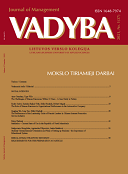Bibliometric Analysis of Human Resource Management (HRM) in the Hospitality and Tourism Industry
Bibliometric Analysis of Human Resource Management (HRM) in the Hospitality and Tourism Industry
Author(s): Dolores Mensah Hervie, Illés Csaba Bálint, Anna Dunay, Mehrzad Abdi KhalifeSubject(s): Supranational / Global Economy, Business Economy / Management, Tourism, Human Resources in Economy, Socio-Economic Research
Published by: Lietuvos verslo kolegija
Keywords: Tourism and Hospitality Industry; Literature; Bibliometric Analysis; Content Analysis; New Agenda;
Summary/Abstract: Tourism industry and hospitality is one of the most labour-intensive industries and it is also one of the fast-growing industries in the world. It has contributed immensely to job creation globally. For instance, the industry accounted for one out of every ten job openings, raising the total number of people depending on the sector for their livelihood to a staggering 319 million in 2018. It also contributed about 8.8 trillion USD to the world’s economy indicating 10.4 percent of the world’s aggregate Gross Domestic Product (GDP). Human resource departments play crucial role in the hospitality and tourism industry. This is because the success of this sector depends mostly on the competencies and attitudes of employees. Human resource managers must understand and be very mindful of the different characteristics and elements of the individuals who comprise the labor force in this industry in order to formulate and implement policies and practices that would motivate the employees in the sector towards commitment and high performance in their respective duties and responsibilities. This study analyzes international scientific literature in the Web of Science on human resource management in the tourism and hospitality industry using bibliometric analysis to determine the relationships among co-authorship, countries, keywords, citation networks, and journals in the chosen field. VOSviewer is a strong software for scientific study network analysis and this software was used to provided clustering, mapping, and visualization of bibliometric’ networks for the study. Longitudinal thematic analysis for human resource in the hospitality industry was also done using strategic diagram mapping and performance analysis approach to identify and visualize the role played by specific and general thematic areas in the study. The most frequent keywords, keywords network and keyword clustering were used for the investigation on the content of the literature. It was found that there was some collaboration among most of the countries. When it comes to the study of human resource management in the hospitality and tourism sector, the Peoples Republic of China is the largest contributor followed by the United States of America. However, the number of coauthors was few. With regard to intellectual structures, the Peoples Republic of China and the United States of America could generally be termed as the same. The differences could be found in the number of authorships per country. The bibliographic coupling visualization also revealed collaborative clusters among the countries. The most important key words identified in the visualization of the study were “performance,” "Commitment,” “Job-satisfaction” and “Antecedent” - these words form an integral part of human resource management. A thematic map is intended to demonstrate a particular subject, contrary to a broad map which has a range of trends occurring together, for example settlements, railways etc. In this study, the themes evolution map gives a broader context to human resource and tourism scholars.
Journal: VADYBA
- Issue Year: 37/2021
- Issue No: 1
- Page Range: 59-80
- Page Count: 22
- Language: English

